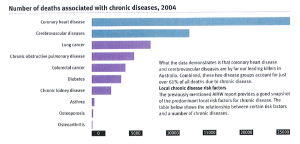Chronic disease is a global epidemic, described as the public health challenge of the 21st century. In developed countries health resources are struggling to meet the demand of those suffering from conditions that are not only chronic, but complex in nature. Those suffering from chronic disease often have multiple conditions that require ongoing care from all sectors of our health care system.
The management of these diseases is not as simple as placing a cast on a broken bone and referring back to primary care for ongoing management. In fact, in Australia (and many other developed countries) we are extremely good at managing acute conditions. What we don’t handle well are the re-admissions and the coordinated model of care that is required to handle those suffering from chronic conditions.
As our population ages, the incidence of chronic disease will no doubt increase even further. In fact, some health professionals and demographers liken this to an approaching ‘tsunami’ that our current system of care is seriously under equipped to handle.
This is where physical activity plays a crucial role in not only managing chronic diseases, but in preventing their incidence. The evidence around physical activity as a key intervention for the treatment and prevention of chronic disease is now robust enough to justify its position as a key ingredient in achieving better health outcomes for all.
What is chronic disease?
Before examining the causes of chronic disease, we need to develop a clear understanding of exactly what a chronic disease is. As was mentioned in the introduction, chronic diseases do not resolve spontaneously and are generally managed rather than cured. Some are immediately life-threatening (i.e., heart attack and stroke) whereas others persist over time (i.e., diabetes) or may not even be the eventual cause of death (i.e., arthritis). One thing that is common is the fact that chronic diseases persist throughout life and require ongoing management.
Although many illnesses could be encapsulated under the banner of chronic disease, the National Public Health Partnership’s paper ‘Preventing chronic disease: a strategic framework’ makes note of 12 particular conditions that pose a significant burden in terms of morbidity, morality and health care cost:
- Ischaemic heart disease (i.e., coronary heart disease)
- Stroke
- Lung cancer
- Colorectal cancer
- Depression
- Type 2 diabetes
- Arthritis
- Osteoporosis
- Asthma
- Chronic obstructive pulmonary disease (COPD)
- Chronic kidney disease
- Oral disease



Local prevalence and cost of chronic diseases
Here are some striking chronic disease statistics in Australia that have been taken from an Australian Institute of Health and Welfare, report titled ‘Chronic diseases and associated risk factors in Australia 2006.’
- In 2004-5, 77% of Australians had at least one long-term condition
- 80% of Australians aged 65+ had three or more long-term conditions
- In 2000-1 chronic diseases accounted for nearly 70% of total health expenditure allocated to diseases
- The major chronic diseases accounted for almost 50% of all deaths with coronary heart disease and stroke being our two biggest killers
- Chronic diseases were responsible for more than 80% of the burden of disease and injury
Author:
Brad McGregor,
Practice Manager and Exercise Physiologist



